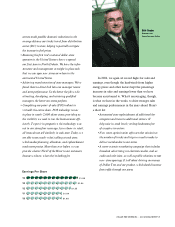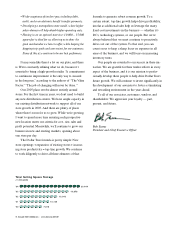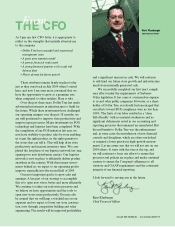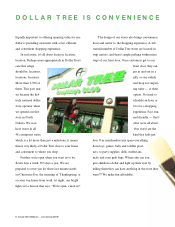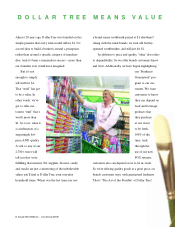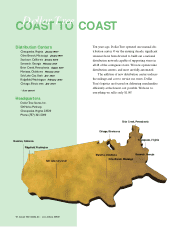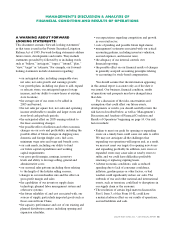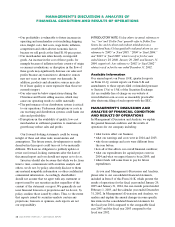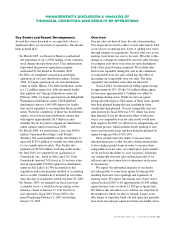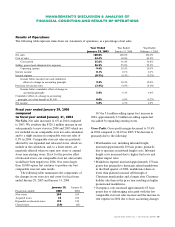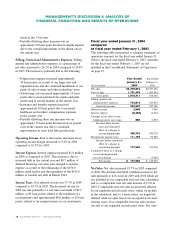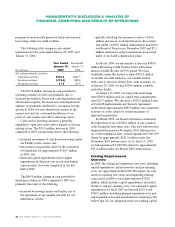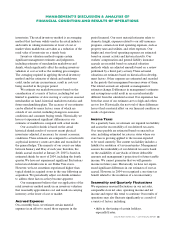Dollar Tree 2004 Annual Report Download - page 17
Download and view the complete annual report
Please find page 17 of the 2004 Dollar Tree annual report below. You can navigate through the pages in the report by either clicking on the pages listed below, or by using the keyword search tool below to find specific information within the annual report.
DOLLAR TREE STORES, INC. • 2004 ANNUAL REPORT 13
A WARNING ABOUT FORWARD
LOOKING STATEMENTS:
This document contains “forward-looking statements”
as that term is used in the Private Securities Litigation
Reform Act of 1995. Forward-looking statements address
future events, developments and results. They include
statements preceded by, followed by or including words
such as “believe,”“anticipate,”“expect,”“intend,”“plan,”
“view,”“target”or “estimate.”For example, our forward-
looking statements include statements regarding:
• our anticipated sales, including comparable store
net sales, net sales growth and earnings growth;
• our growth plans, including our plans to add, expand
or relocate stores, our anticipated square footage
increase, and our ability to renew leases at existing
store locations;
• the average size of our stores to be added in
2005 and beyond;
• the net sales per square foot, net sales and operating
income attributable to smaller and larger stores and
store-level cash payback periods;
• the anticipated effect on 2005 earnings related to
the lease accounting changes;
• the possible effect of inflation and other economic
changes on our costs and profitability, including the
possible effect of future changes in shipping rates,
domestic and foreign freight costs, fuel costs,
minimum wage rates and wage and benefit costs;
• our cash needs, including our ability to fund
our future capital expenditures and working
capital requirements;
• our gross profit margin, earnings, inventory
levels and ability to leverage selling, general and
administrative costs;
• our seasonal sales patterns including those relating
to the length of the holiday selling seasons;
• changes in our merchandise mix and the effect on
gross profit margin and sales;
• the capabilities of our inventory supply chain
technology, planned labor management system and
other new systems;
• the future reliability of, and cost associated with, our
sources of supply, particularly imported goods such as
those sourced from China;
• the capacity, performance and cost of our existing and
planned distribution centers, including opening and
expansion schedules;
• our expectations regarding competition and growth
in our retail sector;
• costs of pending and possible future legal claims;
• management’s estimates associated with our critical
accounting policies, including inventory valuation,
accrued expenses, and income taxes;
• the adequacy of our internal controls over
financial reporting;
• the possible effect on our financial results of changes
in generally accepted accounting principles relating
to accounting for stock-based compensation.
You should assume that the information appearing
in this annual report is accurate only as of the date it
was issued. Our business, financial condition, results
of operations and prospects may have changed since
that date.
For a discussion of the risks, uncertainties and
assumptions that could affect our future events,
developments or results, you should carefully review the
risk factors described below, as well as “Management’s
Discussion and Analysis of Financial Condition and
Results of Operations”beginning on page 14. Our risk
factors include:
• Failure to meet our goals for opening or expanding
stores on a timely basis could cause our sales to suffer.
We may not anticipate all the challenges that
expanding our operations will impose and, as a result,
we may not meet our targets for opening new stores
and expanding profitably. In addition, new stores or
expanded stores may cause sales at nearby stores to
suffer, and we could have difficulties profitably
renewing or replacing expiring leases.
• Adverse economic conditions, such as reduced
spending due to lack of consumer confidence,
inflation, gasoline prices or other factors, or bad
weather could significantly reduce our sales. The
outbreak of war and other national and international
events, such as terrorism, could lead to disruptions in
our supply chain or the economy.
• The resolution of certain legal matters discussed in
Part I, Item 3, of this Form 10-K, could have
a material adverse effect on our results of operations,
accrued liabilities and cash.
MANAGEMENT’S DISCUSSION & ANALYSIS OF
FINANCIAL CONDITION AND RESULTS OF OPERATIONS


